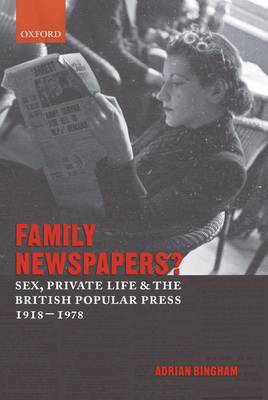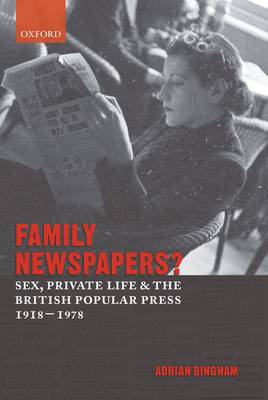
- Afhalen na 1 uur in een winkel met voorraad
- Gratis thuislevering in België vanaf € 30
- Ruim aanbod met 7 miljoen producten
- Afhalen na 1 uur in een winkel met voorraad
- Gratis thuislevering in België vanaf € 30
- Ruim aanbod met 7 miljoen producten
Zoeken
Family Newspapers?
Sex, Private Life, and the British Popular Press 1918-1978
Adrian Bingham
Hardcover | Engels
€ 209,45
+ 418 punten
Omschrijving
Family Newspapers? provides the first detailed historical study of modern popular press coverage of sex and private life, from the start of the mass newspaper reading boom in 1918 to the triumph of the Sun's sexualized journalism in 1978, when circulation overtook that of its rival, the Daily Mirror. In this period, newspapers were at the heart of British popular culture, and Fleet Street's preoccupation with sex meant that the press was a hugely significant source of knowledge and imagery about sexual behavior, personal relationships, and moral codes. Focusing on changing ideas of what sexual content was deemed "fit to print," Adrian Bingham reveals how editors negotiated the tension between exploiting public curiosity about sex and ensuring that their journalism remained within the bounds of acceptability for a "family newspaper." The study challenges established interpretations of social change by drawing attention to the ways in which the press opened up the public discussion of sexuality before the 'permissiveness' of the 1960s. Exploring the spectacular diversity of the press's sexual content--from advice columns to pin-ups, from court reports to celebrity revelations--Bingham offers a rich and thought-provoking investigation of a media form that has done much to shape the character of modern Britain.
Specificaties
Betrokkenen
- Auteur(s):
- Uitgeverij:
Inhoud
- Aantal bladzijden:
- 310
- Taal:
- Engels
Eigenschappen
- Productcode (EAN):
- 9780199279586
- Verschijningsdatum:
- 25/04/2009
- Uitvoering:
- Hardcover
- Formaat:
- Genaaid
- Afmetingen:
- 157 mm x 234 mm
- Gewicht:
- 680 g

Alleen bij Standaard Boekhandel
+ 418 punten op je klantenkaart van Standaard Boekhandel
Beoordelingen
We publiceren alleen reviews die voldoen aan de voorwaarden voor reviews. Bekijk onze voorwaarden voor reviews.











